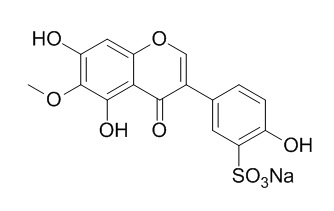Tectorigenin sodium sulfonate
Tectorigenin sodium sulfonate has antioxidant activity.
Inquire / Order:
manager@chemfaces.com
Technical Inquiries:
service@chemfaces.com
Tel:
+86-27-84237783
Fax:
+86-27-84254680
Address:
1 Building, No. 83, CheCheng Rd., Wuhan Economic and Technological Development Zone, Wuhan, Hubei 430056, PRC
Providing storage is as stated on the product vial and the vial is kept tightly sealed, the product can be stored for up to
24 months(2-8C).
Wherever possible, you should prepare and use solutions on the same day. However, if you need to make up stock solutions in advance, we recommend that you store the solution as aliquots in tightly sealed vials at -20C. Generally, these will be useable for up to two weeks. Before use, and prior to opening the vial we recommend that you allow your product to equilibrate to room temperature for at least 1 hour.
Need more advice on solubility, usage and handling? Please email to: service@chemfaces.com
The packaging of the product may have turned upside down during transportation, resulting in the natural compounds adhering to the neck or cap of the vial. take the vial out of its packaging and gently shake to let the compounds fall to the bottom of the vial. for liquid products, centrifuge at 200-500 RPM to gather the liquid at the bottom of the vial. try to avoid loss or contamination during handling.
Molecules.2022, 27(5):1675
Sci Rep.2016, 6:25094
Food Res Int.2020, 133:109130.
Hum Exp Toxicol.2023, 42:9603271221145386.
Pak J Pharm Sci.2023, 36(1):51-57.
BMC Biotechnol.2024, 24(1):94.
Psychopharmacology (Berl).2020, 10.1007
Evid Based Complement Alternat Med.2016, 2016:1230294
Cell Death Discov.2023, 9(1):350.
Environ Toxicol.2021, 36(9):1848-1856.
Related and Featured Products
Food Chem Toxicol. 2012 Feb;50(2):409-14.
In vitro evaluation of tectoridin, tectorigenin and tectorigenin sodium sulfonate on antioxidant properties.[Pubmed:
22079309 ]
Tectoridin (4',5,7-thrihydroxy-6-methoxyisoflavone-7-O-β-d-glucopyranoside) isolated from the flowers of Pueraria thunbergiana is reported to have less hepatoprotective, hypoglycemic, antiallergic and anaphylaxis inhibitory activity than its aglycone form tectorigenin.
METHODS AND RESULTS:
To obtain tectorigenin, tectoridin was hydrolyzed in the current study. However, practical limitations of tectorigenin do exist due to its poor water-solubility. To increase its water-solubility, tectorigenin was sulfonated with sulfuric acid (98wt.%) and mixed with saturated salt water to produce Tectorigenin sodium sulfonate. Tectoridin and the two transfer products were identified by UV, IR, HPLC-MS, (1)H NMR and (13)C NMR, and the solubility of Tectorigenin sodium sulfonate was increased about 9-fold than tectorigenin. Antioxidant experiments of tectoridin, tectorigenin and modified tectorigenin in vitro including reducing power, superoxide anion radical scavenging activity, hydroxyl radical scavenging activity, 1,1-diphenyl-2-picryl-hydrazyl (DPPH) radical scavenging activity and anti-lipid peroxidation were carried on comparing with ascorbic acid (Vc) or butylated hydroxytoluene (BHT).
CONCLUSIONS:
The results suggested that the antioxidant activity in all the experimental systems exhibited the same order as follows: Tectorigenin sodium sulfonate>tectorigenin>tectoridin. Due to the high water-solubility and good antioxidant properties with Tectorigenin sodium sulfonate, appropriate chemical modifications could greatly improve the biological activities of the naturally occurring products.



